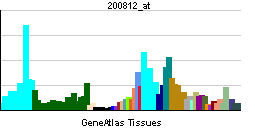CCT7
| Chaperonin containing TCP1, subunit 7 (eta) | |||||||||||
|---|---|---|---|---|---|---|---|---|---|---|---|
| Identifiers | |||||||||||
| Symbols | CCT7 ; CCT-ETA; Ccth; MGC110985; Nip7-1; TCP-1-eta | ||||||||||
| External IDs | Template:OMIM5 Template:MGI HomoloGene: 4694 | ||||||||||
| |||||||||||
| RNA expression pattern | |||||||||||
 | |||||||||||
| More reference expression data | |||||||||||
| Orthologs | |||||||||||
| Template:GNF Ortholog box | |||||||||||
| Species | Human | Mouse | |||||||||
| Entrez | n/a | n/a | |||||||||
| Ensembl | n/a | n/a | |||||||||
| UniProt | n/a | n/a | |||||||||
| RefSeq (mRNA) | n/a | n/a | |||||||||
| RefSeq (protein) | n/a | n/a | |||||||||
| Location (UCSC) | n/a | n/a | |||||||||
| PubMed search | n/a | n/a | |||||||||
Chaperonin containing TCP1, subunit 7 (eta), also known as CCT7, is a human gene.[1]
This gene encodes a molecular chaperone that is a member of the chaperonin containing TCP1 complex (CCT), also known as the TCP1 ring complex (TRiC). This complex consists of two identical stacked rings, each containing eight different proteins. Unfolded polypeptides enter the central cavity of the complex and are folded in an ATP-dependent manner. The complex folds various proteins, including actin and tubulin. Alternate transcriptional splice variants encoding different isoforms have been found for this gene, but only two of them have been characterized to date.[1]
References
Further reading
- Kubota H, Hynes G, Carne A; et al. (1994). "Identification of six Tcp-1-related genes encoding divergent subunits of the TCP-1-containing chaperonin". Curr. Biol. 4 (2): 89–99. PMID 7953530.
- Maruyama K, Sugano S (1994). "Oligo-capping: a simple method to replace the cap structure of eukaryotic mRNAs with oligoribonucleotides". Gene. 138 (1–2): 171–4. PMID 8125298.
- Hynes G, Celis JE, Lewis VA; et al. (1997). "Analysis of chaperonin-containing TCP-1 subunits in the human keratinocyte two-dimensional protein database: further characterisation of antibodies to individual subunits". Electrophoresis. 17 (11): 1720–7. doi:10.1002/elps.1150171109. PMID 8982604.
- Liou AK, Willison KR (1997). "Elucidation of the subunit orientation in CCT (chaperonin containing TCP1) from the subunit composition of CCT micro-complexes". EMBO J. 16 (14): 4311–6. PMID 9250675.
- Suzuki Y, Yoshitomo-Nakagawa K, Maruyama K; et al. (1997). "Construction and characterization of a full length-enriched and a 5'-end-enriched cDNA library". Gene. 200 (1–2): 149–56. PMID 9373149.
- Won KA, Schumacher RJ, Farr GW; et al. (1998). "Maturation of human cyclin E requires the function of eukaryotic chaperonin CCT". Mol. Cell. Biol. 18 (12): 7584–9. PMID 9819444.
- Yokota S, Yanagi H, Yura T, Kubota H (2001). "Cytosolic chaperonin-containing t-complex polypeptide 1 changes the content of a particular subunit species concomitant with substrate binding and folding activities during the cell cycle". Eur. J. Biochem. 268 (17): 4664–73. PMID 11532003.
- Suzuki H, Fukunishi Y, Kagawa I; et al. (2001). "Protein-protein interaction panel using mouse full-length cDNAs". Genome Res. 11 (10): 1758–65. doi:10.1101/gr.180101. PMID 11591653.
- Strausberg RL, Feingold EA, Grouse LH; et al. (2003). "Generation and initial analysis of more than 15,000 full-length human and mouse cDNA sequences". Proc. Natl. Acad. Sci. U.S.A. 99 (26): 16899–903. doi:10.1073/pnas.242603899. PMID 12477932.
- Imai Y, Soda M, Murakami T; et al. (2004). "A product of the human gene adjacent to parkin is a component of Lewy bodies and suppresses Pael receptor-induced cell death". J. Biol. Chem. 278 (51): 51901–10. doi:10.1074/jbc.M309655200. PMID 14532270.
- Hanafy KA, Martin E, Murad F (2004). "CCTeta, a novel soluble guanylyl cyclase-interacting protein". J. Biol. Chem. 279 (45): 46946–53. doi:10.1074/jbc.M404134200. PMID 15347653.
- Gerhard DS, Wagner L, Feingold EA; et al. (2004). "The status, quality, and expansion of the NIH full-length cDNA project: the Mammalian Gene Collection (MGC)". Genome Res. 14 (10B): 2121–7. doi:10.1101/gr.2596504. PMID 15489334.
- Hillier LW, Graves TA, Fulton RS; et al. (2005). "Generation and annotation of the DNA sequences of human chromosomes 2 and 4". Nature. 434 (7034): 724–31. doi:10.1038/nature03466. PMID 15815621.
- Stelzl U, Worm U, Lalowski M; et al. (2005). "A human protein-protein interaction network: a resource for annotating the proteome". Cell. 122 (6): 957–68. doi:10.1016/j.cell.2005.08.029. PMID 16169070.
- Guo D, Han J, Adam BL; et al. (2005). "Proteomic analysis of SUMO4 substrates in HEK293 cells under serum starvation-induced stress". Biochem. Biophys. Res. Commun. 337 (4): 1308–18. doi:10.1016/j.bbrc.2005.09.191. PMID 16236267.
| This protein-related article is a stub. You can help Wikipedia by expanding it. |